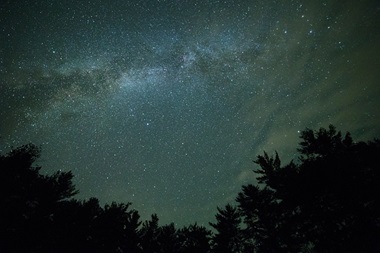Environmentalist go dark protecting night skies
The Oregon Outback International Dark Sky Sanctuary (OOIDSS) is a 2.5 million-acre protected area in Lake County, Oregon, which is the largest Dark Sky Sanctuary in the world. Located in a remote and sparsely populated area of southeastern Oregon, this sanctuary is a haven for astronomers, photographers, and anyone eager to gaze upon the unspoiled beauty of the cosmos.
The area is known for its breathtaking night sky viewing experiences, with minimal light pollution allowing for unparalleled stargazing opportunities. The 2.5-million-acre sanctuary about one-half the size of New Jersey, and is part of a larger project aiming to encompass 11.4-million-acres of contiguous, protected night sky, making it over twice the size of New Jersey.
Within the OOIDSS are the unincorporated communities of Adel, Plush, and Summer Lake, the Hart Mountain National Antelope Refuge, a portion of the Fremont-Winema National Forest, nearly 1.7 million acres of land managed by the U.S. Bureau of Land Management, the Oregon Department of Fish and Wildlife’s Summer Lake Wildlife Area, nearly 80,000 acres of state-owned rangeland, and the Oregon Outback Scenic Byway.
The OOIDSS is the certification given by DarkSky International, a nonprofit organization that works to “protect the night” for the benefit of people and wildlife by advancing responsible outdoor lighting. The International Dark Sky Places Program was founded in 2001, as a non-regulatory and voluntary program to encourage communities, parks, and protected areas around the world to preserve and protect dark sites through effective lighting policies, environmentally responsible outdoor lighting, and public education.
As Oregon rural counties are looking for opportunities to replace the income from the cut in timber sales, the OOIDSS could partially fill-in by increasing tourism. Bob Hackett, Executive Director of Travel Southern Oregon said, “This four-year collaboration brings together so many of the elements we try to achieve in regenerative tourism. It not only elevates the destination experience for visitors to Lake County and opens up opportunities for local businesses, but it also helps agencies and residents steward their lands in ways that celebrate a legacy of starry night skies for generations to come.”
A D V E R T I S E M E N T

A D V E R T I S E M E N T
It’s a high desert area characterized by sage scrub and abrupt changes in topography that alternates between narrow faulted mountain chains and flat, arid valleys and basins. Within this unique geography of geological wonders is priority habitat for an array of wildlife, including American pronghorn, bighorn sheep, sage grouse, white-tailed jack rabbit, and migratory birds navigating the Pacific Flyway. The region is also culturally significant and is home to a 13,000-year-old human occupation site. Dispersed within the OOIDSS are hot springs, wild horses, private rangelands, ranches, and cattle.
The
DarkSky Oregon chapter has established a network of continuously
recording Sky Quality Meters (SQMs) in Oregon to measure skyglow. Skyglow is literally the measurement of the glowing sky at night, due to both man-made artificial light and natural light. The project’s primary aim is to quantitatively measure, interpret, and share skyglow measurements in Oregon to better understand the current level of light pollution in comparison to other regions and to document any changes over a five-year period. The skyglow data will help to inform action toward healthier and safer communities with less light pollution.
Atmospheric conditions such as cloud cover, haze, and air pollution such as wildfires, chemtrails, and CO2 can also limit visibility in night skies. Some controllable and some are natures processing.
--Dollie Banner| Post Date: 2024-06-26 16:29:33 | Last Update: 2024-06-26 19:18:20 |







